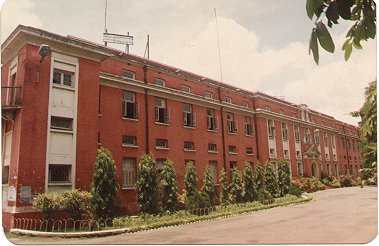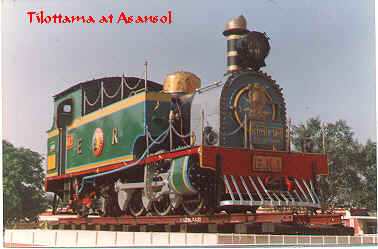|
HISTORY
This division formed in 1925 has been
historically connected with the railway revolution in India. EIR Company was
established in February,1847. The line from Howrah to Pandooah (61 Km.) was
ready in 1853. Finally on 1st. February 1855 A train was run from Howrah to
Raniganj (194 Km). This accelerated development of trade and commerce in eastern
region and was extended towards Delhi. There was enormous increase of traffic
and it was then felt necessary to create Asansol division in 1925, one of the
oldest division in IR.
During the middle of nineteenth century
the coal was being transported by boat from Narayan kuri Ghat of Damodar river,
Searsole (Now Raniganj) to Calcutta by M/S Carr Tagore & Company, owned by
Dwarakanath Tagore. However, this supply was not uniform and enough because the
level of water varied in the river Damodar with the varying seasons. So as to
capture this lucrative business of coal transportation that East Indian Railway
laid the lines up to Raniganj in 1855. It succeeded in its motive and captured
the entire coal transportation business. This line was extended up
to Asansol in
July 1863 via Searsole (now Raniganj) and Kalipahari.
The coal business started to flourish and consequently the train movements
increased. The East Indian Railway (E.I.R.) needed large and expansive land area
to build an infrastructure to run the Railways smoothly. Obviously, Raniganj was
their choice for it was a much more developed business hub in those days because
of the coal mines . They requested the Malias, the Raj family of Searsole (Raniganj)
to provide them with sufficient land. But the Raj family did not accept the
proposal since it was apprehended that black smoke and coal dust from
steam locomotives would cause a pollution leading to health hazards.
ASANSOL & THE RAJA OF PANCHKUT
However, in 1863-64, this was seen as an opportunity by the Raj family of
Panchakut (Cossipore, Adra) who sold a vast area of jungle land then known as "Shergarh"
to the EIR. Asansol was a part of Shergarh. This happened in 1863-64, ushering
the foundation of Asansol's march towards a modem industrial township.
In early days only two officers DVS i.e. Divisional Vehicular Supdt. (later DS and
now DRM) and Sr. Supdt. of Works [later DEN and now Sr. DEN lived in bungalows
situated on the road leading from the present station to the G.T. Road near the
Nazrul Sarani. They used to run their offices from their bungalows.
A full fledged DVS(DRM) Office was set
up in a two storied building in 1880 on the west side of the present station
road. The building at present serves the purpose of staff quarters. The Division
got its new Divisional building in the year 1928 ( Picture above) to which an
annexes was added in 1958. The Divl. Vehicular Supdt. was upgraded to Divisional
Supdt. in 1950s and a separate DVS office was created under Asansol Division in
Dhanbad in 1959. Soon this was upgraded to Divisional Supdt. thus creating
Dhanbad Division after carving out a sizeable portion from Asansol
division.
SCHOOLS & CLUBS
In 1877 some started the St. Vincent Technical School. The land was purchased
from Railways at a very nominal cost. This school aimed to produce trained
Mechanical and Electrical artisan staff.
In the same year a Bengali medium school was started which has now grown into
the prestigious "East Indian Railway Boys' High School". This was later renamed
as "Eastern Railway Boys' High School"
Two magnificent buildings were setup in the heart of the town to provide
recreation to the Railway staff.
THE DURAND INSTITUTE
Set up in 1878 , It got the name of 'European Institute' in 1915. In 1925 it was
renamed as 'Durand Institute' after Sir Mortimer Durand, the architect of the
famous Durand line between Afghanistan, Tibet and India. Now we call it
'Vivekananda Institute' from 1987. This Institute has the distinction of being
the first recreational institute on the entire Indian Railways. It was set up
primarily to serve the recreational needs of the mechanical engineers of East
Indian Railway. This institute was very popular among the high officials of E.I.R., right from Calcutta to Saharanpur, and they craved to dance in the
sophisticated dance hall during the Christmas festival. The entire floor was
made of Burma Teak! However, entry to this institute was restricted only to the
Europeans. Indians found entry only after Independence.
THE INDIAN INSTITUTE
The second one was setup in the year 1915 to meet the recreational demands of
the Indian. The Institute became functional in the year 1917.Later on the eve of
independence the Institute came to be known as 'Subhash Institute' after the
name of great freedom fighter of India, Netaji Subhas Chandra Bose. The
Institute promoted cultural sports activities among Railway Employees.
This
institute started cinema shows in 1925 with the help of Arora Studio. Later with
the Independence movement catching up the institute became a centre of patriotic
activities..
The division has got the largest goods yard at Andal, apart from Sitarampur and
Barakar. The marshalling of wagons at Andal is done by a hump yard fitted with
mechanical retarders. It has large number of collieries to serve and loads an
average of 1300 wagons daily. Apart from this it handles about 4400 wagon FW
units daily. The main commodities dealt
are coal from Raniganj, Mugma, Jamtara and Giridih, steel products from Durgapur
and IISCO at Burnpur, petroleum product from Rajbandh and huge parcel traffic
from Asansol and Jasidih.
SHEDS
This has A Diesel Loco Shed at Andal
.
Electric Loco Shed at Asansol
One MEMU shed
at Asansol.
PLACES TO VISIT
Mython Dam : Famous for sight seeing and Health resort. Can be approached from Barakar by
road.
Panchet Dam : Famous for sight seeing. By road from Kumardhubi.
Baidyanthdham :
Deoghar,
the house of God,
as it more commonly known is on a branch line from Jasidih at a distance of 8
Km. This is one of the most ancient Hindu pilgrimage of the country. Famous for
temple of Lord Shiva. It is believed that Ravana the king of Lanka brought the
"Jyotirlinga" from Kailash and got it consecrated here. Later this
became to be known as Baidyanath Shiva Linga.
Simultala : Famous for health resort and flower
nursery.
|



